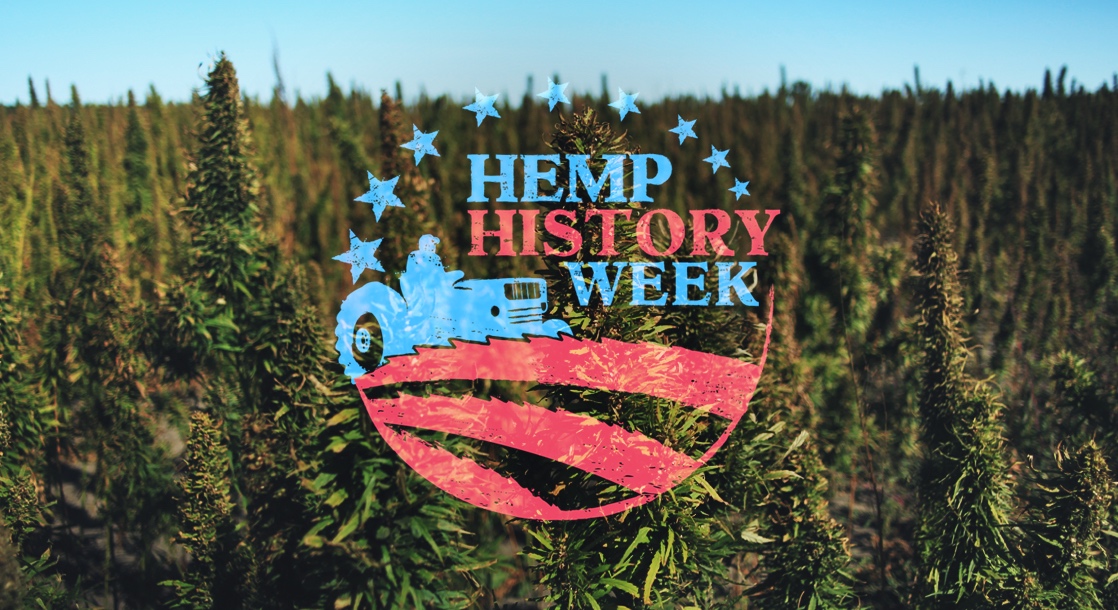It wasn’t until the twentieth century that hemp fell out of favor as one of the most important crops in the history of mankind. In 2016, however, anything is possible it seems.
So, it could be very soon where a variety of applications using hemp become economical, and hemp grows into a boon for society.
What was once a widespread plant became a taboo within decades. Its history shows it is useful for tens of thousands of applications and counting.
So, in honor of Hemp History Week, which takes place from June 6-12, MERRY JANE put together a list of the 51 things you need to know about hemp:
- 150 million years ago, after the Big Bang, plants began to grow amongst dinosaurs. (Alternative version: God invents the world plants, including hemp and hundreds of thousands of others plants)
- The hemp plant grows from a seed, and can grow up to 15 to 20 or so feet tall. It grows generally as an annual, and is a long fibre plant.
- When archaeologists found a remnant of hemp cloth in ancient Mesopotamia (today’s Iran and Iraq), thereafter dating it to 8,000 B.C., it provided evidence hemp was likely the earliest plant cultivated for use as a textile fiber.
- China likely has the longest history of hemp cultivation. It is said to span 6,000 years.
- Some say that in the year 1,200 B.C., hemp fiber was used to construct the Pyramids. How they were actually built is traditionally considered unknown.
- France has cultivated hemp for no less than 700 years to today. Spain and Chile have cultivated for a similar amount of time.
- Although not associated with the plant, Russia was a major grower and supplier of hemp for hundreds of years.
- In around 150 BC, the Chinese produced the world’s first paper from hemp.
- Buddhist texts, which are dated to the 2nd and 3rd centuries AD, are considered the oldest documents written on paper. And—you guessed it—they were written on hemp paper. (How’d ya know?)
- The medical uses for hemp are made clear by the literature, and the plant had been passed down for centuries as a medicine. Seeds and flowers of the hemp plant, for instance, were recommended for difficult childbirth, convulsion, arthritis, rheumatism, dysentery and insomnia.
- Hemp was an important crop during the Middle Ages, providing much of the world with it’s food and fiber.
- Sailing ships were made possible thanks to hemp.
- The word 'canvas' might be derived from the word 'cannabis'.
- Some believe Native Americans used hemp seeds. Scholars say captive slaves brought them from Africa.
- In the 16th century, Jacques Cartier wrote that the North American soil was “frill of hempe which groweth of itselfe, which is as good as possibly may be scene, and as strong.”
- Since hemp was such an important resource for the American colonies, it was illegal not to grow hemp in Jamestown, Virginia in 1619.
- Americans had to legally grow hemp generally during the Colonial Era and Early Republic.
- Before Canada became a country, hemp was grown in its western and central provinces.
- The French Regime during the eighteenth century is said to have subsidized the hemp plant before any other crops.
- Today, a fortune 500 company in France called Kimberly Clark prints bibles on hemp-based paper.
- The invention of the mechanical cotton gin at the end of the eighteenth century made cotton easier to produce than hemp. Hemp fell out of favor.
- The Declaration of Independence was written on hemp paper.
- U.S. Presidents Washington and Jefferson each grew hemp.
- George Washington, the first President of the United States, once said: "I am very glad to hear that the Gardener has saved so much of the St. foin seed, and that of the India Hemp. Make the most you can of both, by sowing them again in drills. . . Let the ground be well prepared, and the Seed (St. foin) be sown in April. The Hemp may be sown any where."
- Thomas Jefferson, second president of the United States, once said: “Hemp is of first necessity to the wealth and protection of the country.”
- Benjamin Franklin is said to have started the first hemp paper mill, the product of which fueled the Colonial Press. Others aren’t so sure.
- At the end of the nineteenth century, the Shely Fiber Breaker was invented. According to Scientific American, the machine was “designed to break six to eight thousands pounds of hemp or similar fiber per day.”
- California, a leading global agricultural hub today, grew hemp throughout the state from about 1900 to 1920.
- However, California was the first state to list cannabis as a poison in The Poison Act.
- The state made a misdemeanor the possession of “extracts, tinctures and other narcotic preparations of hemp, or loco-weed, their preparations and compounds”
- Henry Ford’s Model-T was first built to run on hemp fuel and the car was constructed from the hemp plant. Ford apparently had his own hemp field.
- U.S.-based big business and government undermined the hemp industry in the 1930s. Propaganda bedeviled hemp, as petroleum based textile companies, media interests and barons.
- Written in early 1937, the February 1938 issue of Popular Mechanics stated that hemp would become “the billion-dollar crop.”
- That same article cited more than 25,000 various products which could be created from hemp.
- In 1937, the U.S. government drafted prohibitive tax laws on hemp dealers. Enforcement of the Marihuana Tax Act of 1937 ended a profitable hemp industry. Hemp production was soon banned altogether.
- Canada’s government prohibited hemp production under its Opium and Narcotics Act in 1938.
- To meet the demands of World War II, both the U.S. and Canadian government allowed the production of hemp once more. Farmers had to have special permits to grow hemp for the war effort.
- The film Hemp for Victory was released by the United States Department of Agriculture. According to the film: “In 1942, patriotic farmers at the government’s request planted 36,000 acres of seed hemp, an increase of several thousand percent. The goal for 1943 is 50,000 acres of seed hemp.”
- In June of 1942, this photo appeared in Farm Journal and Farmer’s Wife. The caption reads: “All the hempseed available in the U.S. is stacked in this Kentucky warehouse under armed guard.”
- After the War, the hemp ban persisted, itself a victim of a global War on Drugs.
- A map published by the USDA in 1970 demonstrated that hemp could be grown throughout most of the United States. Today, the plant is far more widespread.
- The 1970 Controlled Substances Act makes industrial hemp a type of marijuana and thus farming is made illegal.
- In 1999, U.S. Customs seized 40,000 pounds of bird seed on the border of Canada. The feed had sterilized hemp seeds. Jean Laprise, the farmer who grew the seed, told the New York Times: "They say it's a tractor-trailer full of drugs. We say it's a tractor-trailer full of birdseed."
- In 2014, the Farm Bill sought to allow industrial hemp cultivation in the United States.
- In February 2015, two cannabis related bills were introduced in the U.S. Congress that sought to make the hemp plant legal at the federal level.
- Hemp has long been cited as an alternative to fossil fuels. Proponents claim it burns cleanly and could thus reduce pollution.
- Hemp was legally planted on Virginia soil in June 2016 for the first time since World War II.
- The popularity of craft brewing has resulted in many craft brewers using hemp, such as Humboldt Brewing Co.
- A variety of the plant species, hemp, or cannabis sativa L, won’t get you high.
- The hemp plant proves highly resistant to many insects and diseases. Many argue this means the plant does not need as many pesticides and herbicides, if any, to grow abundantly. That means it can be grown organically.
- France is the world's largest hemp produce, and China is a close second.

Pictured: Shely Fiber Breaker

Pictured: Two "hemp guards" guarding hemp

Pictured: Map of Cannabis sativa L
Any other facts you think others should know about hemp? Let us know in the comments!











